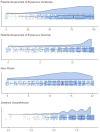Language Screening in 3-Year-Olds: Development and Validation of a Feasible and Effective Instrument for Pediatric Primary Care
- PMID: 34888268
- PMCID: PMC8650498
- DOI: 10.3389/fped.2021.752141
Language Screening in 3-Year-Olds: Development and Validation of a Feasible and Effective Instrument for Pediatric Primary Care
Abstract
Objective: The study was aimed at evaluating the validity and feasibility of SPES-3 (Sprachentwicklungsscreening), a language screening in 3-year-old children within the constraints of regular preventive medical check-ups. Methods: A four-component screening measure including parental reports on the child's expressive vocabulary and grammar based on the MacArthur Communicative Development Inventory and pediatrician-administered standardized assessments of noun plurals and sentence comprehension was used in a sample of 2,044 consecutively seen children in 30 pediatric offices. One-hundred forty-four children (70 who failed and 74 who passed the screener) comprised the validation sample and also underwent follow-up gold standard assessment. To avoid verification and spectrum bias multiple imputation of missing diagnosis for children who did not undergo gold standard assessment was used. Independent diagnoses by two experts blinded to the screening results were considered gold standard for diagnosing language disorder. Screening accuracy of each of the four subscales was analyzed using receiver operator characteristic (ROC) curves. Feasibility was assessed by use of a questionnaire completed by the pediatricians. Results: The two parental screening subscales demonstrated excellent accuracy with area under the curve (AUC) scores of 0.910 and 0.908 whereas AUC scores were significantly lower for the subscales directly administered by the pediatricians (0.816 and 0.705). A composite score based on both parental screening scales (AUC = 0.946) outperformed single subscales. A cut off of 41.69 on a T-scale resulted in about 20% positive screens and showed good sensitivity (0.878) and specificity (0.876). Practicability, acceptability and sustainability of the screening measure were mostly rated as high. Conclusion: The parent-reported subscales of the SPES-3 language screener are a promising screening tool for use in primary pediatric care settings.
Keywords: feasibility; language disorder; language-delayed children; pediatric; pre-school age; validity.
Copyright © 2021 Holzinger, Weber, Barbaresi, Beitel and Fellinger.
Conflict of interest statement
The authors declare that the research was conducted in the absence of any commercial or financial relationships that could be construed as a potential conflict of interest.
Figures
References
LinkOut - more resources
Full Text Sources



